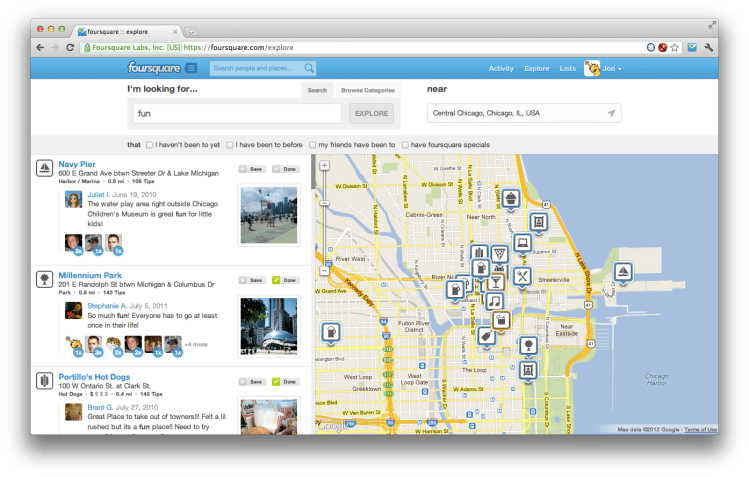Chances are that the insights gathered from one-and-a-half billion check-ins and 15 million tips are better than your own eyes and ears at sleuthing out the best places to eat, drink and see nearby or afar. At least that’s the logic and science behind Foursquare Explore, a popular recommendation feature migrating from mobile to web today.
Foursquare is the New York-based location-sharing startup that popularized the place check-in. But spend a few minutes talking to Foursquare founder Dennis Crowley and you’ll soon realize that the startup, as he sees it, is in the business of building software that makes the real world easier to use. And that’s where Explore — first introduced in the company’s mobile apps in March 2011 — comes in.
Explore on the web, rolling out to users now, is a personalized search engine for places that gives you Foursquare’s best picks for where to go, whatever your fancy. The feature is powered by the startup’s always-expanding, massive check-in and tips repository. It even factors in your personal preferences and your friends’ previous activities.
“There are place recommendations out there are one-size-fits-all,” Foursquare’s head of product Alex Rainert told VentureBeat. “But we have data to help you find the places you might like,” he added, indicating that the places Foursquare recommends via Explore are unique to each user. “The more you check in, the smarter it gets.”
You can “explore” by browsing through food, coffee, nightlife, shopping, arts and outdoors categories, or by searching for something more specific, like “vegan food,” or something far more ambiguous, say “fun.” The results are ranked by their likelihood to please.
The web-based version of Explore nicely complements the mobile version, and comes with a few enhancements. Web searches via Explore, for instance, are not limited to nearby results, meaning you can search anywhere in the world and plan ahead for future trips.
The web interface also awards the searcher with more real-estate for visual discovery and additional context. A large map at the right should help you quickly pinpoint venue locations, while a left-hand venue menu provides detailed venue snippets and allows for one-click place-saving to to-do lists (fun fact: Foursquare members have created more than 500,000 to-do lists).
“Explore is part of the virtuous circle of location-based content that we’re trying to design products around,” Rainert said.
That circle, as Rainert described it, is the lifecycle that starts with the person discovering location-based content of interest and ends with her finding that content when its most relevant. The cycle has you discovering a new place or activity via Explore, saving that place to a to-do list and then receiving a notification when you’re nearby (with Radar), and it’s a process that the startup would like to see uninterrupted as you jump between web and mobile applications.
And while the mobile applications have consistently been top priority for the startup, the company is finding that its latest redesign has opened the door for creating even richer experiences specifically for its growing population of web visitors. Foursquare’s website now sees about a million visitors each day, Rainert said.
The company is so committed to cross-platform place discovery that it recently hired Andrew Hogue, a former Google senior engineer, to the lead its search and data team and improve the Explore experience.
“We want people to think of Foursquare as a place to store all the things they want to do,” Rainert stressed.


